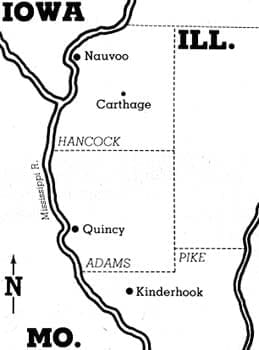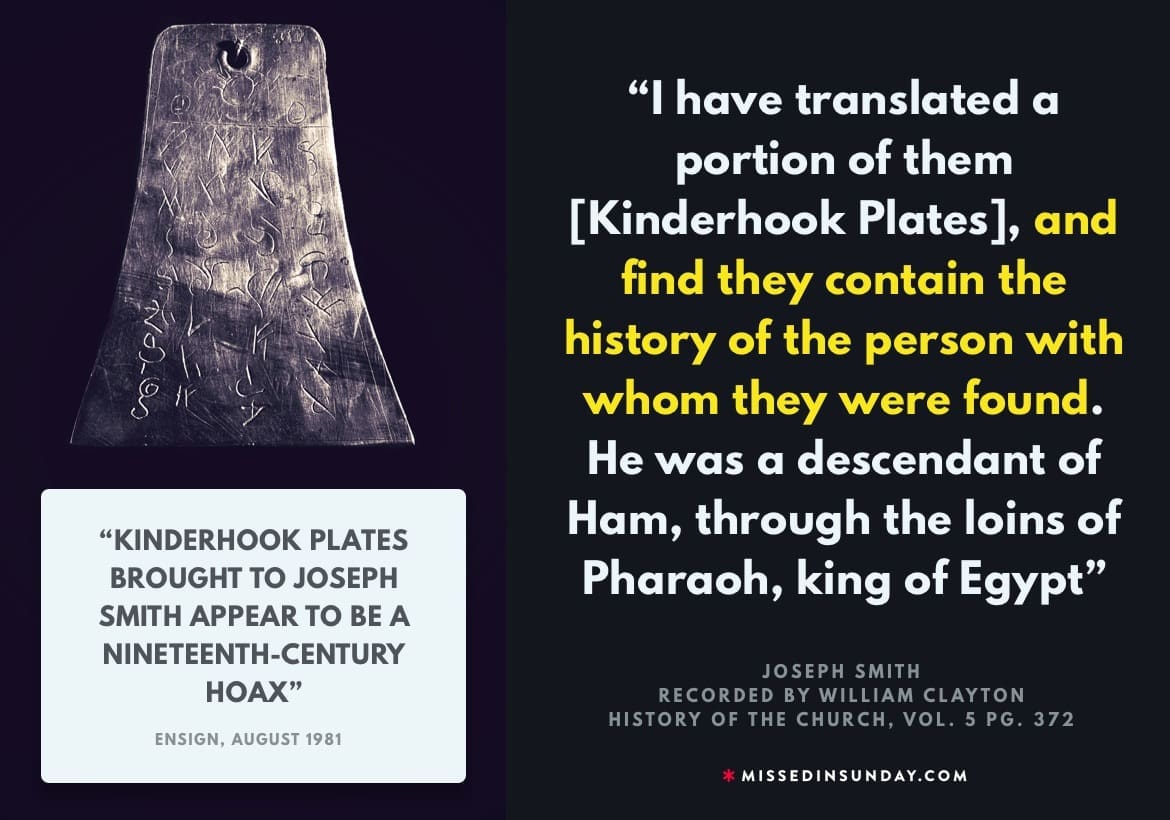Kinderhook Plates
While most members of the LDS Church are familiar with the narrative of Joseph Smith obtaining golden plates containing an undiscovered Egyptian-Hebrew language, fewer are aware of the Kinderhook plates, the other set of unearthed metal plates that Smith claimed to translate. This essay provides a fascinating glimpse into Smith’s interaction with the fraudulent plates, his efforts to translate them, and the Church’s ongoing promotion of them as authentic ancient records long after their creators came forth to reveal the plates to be an elaborate hoax.
It is difficult to determine if Smith was indeed duped or whether he simply realized that these plates were useful to bolster his story of gold plates as the source of the Book of Mormon, but what is clear is that the members of the LDS Church continued to hold to the belief that the plates were authentic, because they were difficult to dismiss without simultaneously dismissing Smith as a translator. Taken in context with the obviously incorrect translation of the Egyptian papyri that were proclaimed scripture in the Book of Abraham, and lingering questions about the historicity of the Book of Mormon, the fallibility of Smith in this case presents many challenges to his capacity to receive revelation or translate anything.
WHAT ARE THE KINDERHOOK PLATES
Allegedly prompted by a dream which he experienced over three successive nights, Robert Wiley began an excavation on April 16, 1843 for ancient artifacts in Kinderhook, IL. As the dig expanded, others were invited to participate and observe, including members of the LDS Church from nearby Nauvoo. On April 23, the dig produced a collection of six bell-shaped brass plates covered in unknown symbols.
The newly discovered plates were promptly brought to Joseph Smith, presumably to determine if he could translate them. Joseph was allowed to examine the plates for a length of time, even openly displaying them in his home for visitors to inspect. Nine citizens certified that Wiley had taken the plates from a dig in the vicinity.
A PORTION TRANSLATED
The plates remained on display in Joseph Smith’s home, enabling his trusted scribe, William Clayton, to examine the plates directly before recording in his journal on May 1, 1843: “I have seen 6 brass plates which were found in Adams [Pike] County by some persons who were digging in a mound. They found a skeleton about 6 feet from the surface of the earth which was 9 foot high. [At this point there is a tracing of a plate in the journal.] The plates were on the breast of the skeleton. This diagram shows the size of the plates being drawn on the edge of one of them. They are covered with ancient characters of language containing from 30 to 40 on each side of the plates. Pres[iden]t J[oseph] has translated a portion and says they contain the history of the person with whom they were found and he was a descendant of Ham through the loins of Pharaoh king of Egypt, and that he received his kingdom from the ruler of heaven and earth.” [1]
The LDS Church perceived this magnificent translation episode to be so important that, when it tasked B.H. Roberts with preparing its foremost publication in 1930, History of the Church, it converted Clayton’s words into Joseph’s first-person voice. The Church dedicated eight valuable pages to sharing the story of the Kinderhook plates, likely at least in part, because the story bolstered the otherwise unsupported notion that inscribing Egyptian characters onto thin metal plates was a valid method of recordkeeping in the ancient Americas.
Clayton’s journal sheds additional light on his extraordinarily close relationship with the prophet. It records his officiating in Smith’s secret marriage to his housemaid, Lucy Walker, that very morning at the prophet’s residence. This episode appears consistent with the fact that Lucy resided in the Smith family’s home. His journal entries indicate that he remained at Smith’s house while the prophet went out to borrow money from William Allen to repay a debt to Mr. Lucien Woodworth, and that he remained at Smith’s home after his return. Clayton’s journal contains a tracing of a single plate, which he prepared during his day in Smith’s home before also taking supper with him.
News of the discovery of the Kinderhook plates was promoted in the Church’s own Times and Seasons, a Nauvoo publishing house which Joseph Smith acquired the previous year: “We learn there was a Mormon present when the plates were found, who it is said, leaped for joy at the discovery, and remarked that it would go to prove the authenticity of the Book of Mormon – which it undoubtedly will.” [2]
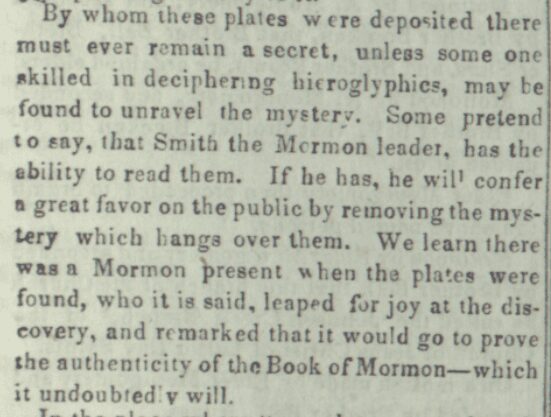
The plates generated great interest among the highest circles of LDS leadership. Brigham Young, President of the Twelve Apostles, traced an outline of one of the plates into his personal journal on May 3, including the comment “I took this at Joseph Smiths house…” [3] Reuben Hedlock prepared wood cut facsimiles of the Kinderhook plates for publication.
Parley P. Pratt penned a letter to his cousin on May 7, confirming the primary details of the event and comparing it to the Book of Abraham papyrus, while introducing details which contradict Clayton’s account: “Six plates having the appearance of Brass have lately been dug out of a mound by a gentleman in Pike Co. Illinois. They are small and filled with engravings in Egyptian language and contain the genealogy of one of the ancient Jaredites back to Ham the son of Noah. His bones were found in the same vase (made of Cement). Part of the bones were 15 ft. underground.…A large number of citizens have seen them and compared the characters with those on the Egyptian papyrus which is now in this city.” [4]
Joseph Smith’s own journal, as recorded by his secretary Willard Richards on May 7, confirms that the prophet “was visited by several gentlemen concerning the plates which were dug out of a mound near Quincy, and he sent by William Smith to the office for his Hebrew Bible [sic] and Lexicon.” The lexicon referred to is none other than Smith’s Grammar and Alphabet of the Egyptian Language (GAEL), a translation cross-reference tool he created during his now discredited translation attempt of the Egyptian papyri which spawned the Book of Abraham. This leads one again to wonder if Smith was duped or going along with the pretense, but Pratt and Young were certainly believers in the plates.
A third source corroborating the events of May 7th is provided by the New York Herald’s May 30th publication of a letter from a participant in the excitement. He reported that “the plates are evidently brass, and are covered on both sides with hieroglyphics. They were brought up and shown to Joseph Smith. He compared, in my presence, with his Egyptian alphabet…and they are evidently the same characters. He will therefore be able to decipher them.” It seems clear why many thought that these plates were of great value to Mormonism, because they seemed to indicate that such plates were commonplace in the ancient world of native America, and that they were written in reformed Egyptian that a man like Joseph Smith could translate.
This was followed on May 10 by the publication of a ‘broadside’ in the Nauvoo Neighbor, republishing the Times and Seasons editorial, facsimiles of all twelve sides of the plates, and a footer declaring that “the contents of the plates… will be published in the ‘Times and Seasons,’ as soon as the translation is completed.” [5] Thus, members were given the impression that a full translation was forthcoming, though Smith died before that was possible.
Though members today have likely never heard of the Kinderhook plates, as great efforts are taken to bury the less faith inspiring aspects of its own history, the LDS Church continued to defend the plates well into the 1970s, a century after the fraud had been admitted to by the original conspirators involved in the project.
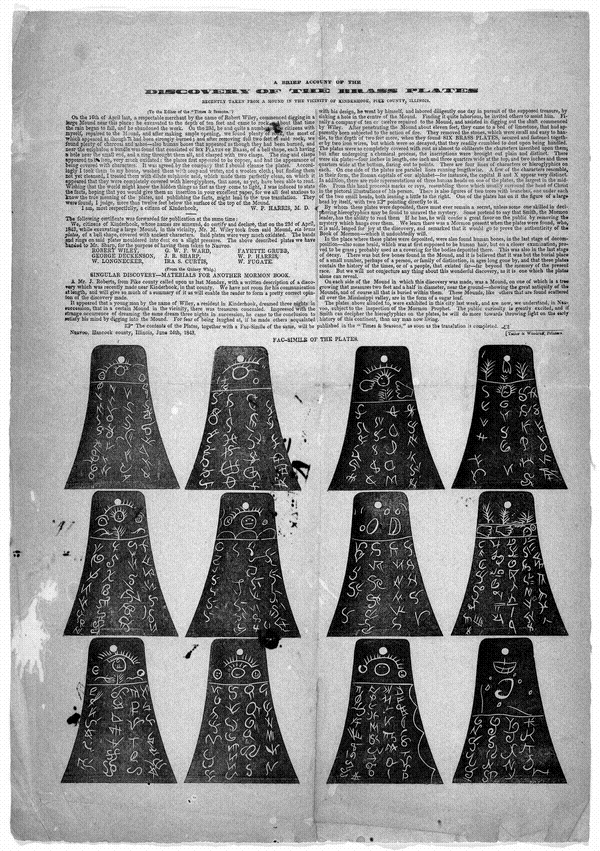
TIMELINE OF IMPORTANT EVENTS
May 30, 1843: The New York Herald published a letter from a man who participated in the events of May 7 at Joseph’s home, inspecting the plates. The article reports that Joseph compared “in my presence, with his Egyptian Alphabet.” It is important to recognize that the spine of the notebook containing Smith’s GAEL is labeled “Egyptian Alphabet.”
December 1, 1843: Times and Seasons again promoted the Kinderhook plates: “Why does the circumstance of the plates recently found in a mound in Pike county, III., by Mr. Wiley, together with ethnology and a thousand other things, go to prove the Book of Mormon true? – Answer: Because it is true!” [6]
May 22, 1844: The Warsaw Signal reported that Smith remained “busy in translating them. The new work…will be nothing more nor less than a sequel to the Book of Mormon…”
April 25, 1856: W.P. Harris, one of the original nine conspirators, penned a letter explaining his role in the event. He reaffirmed that his affidavit affirming the discovery was “honest,” but since that time Bridge Whitten admitted to fabricating the plates. [7]
1861-1865: Sometime during the Civil War, the original brass Kinderhook plates were lost.
June 30, 1879: Wilbur Fugate, one of the original nine conspirators, replied to a letter from James Cobb, Brigham Young’s step-son in Salt Lake City, confirming to him that the Kinderhook plates were a hoax intended to trick Joseph Smith into translating bogus plates. His sworn statement was received by Jay Brown, Justice of the Peace. “I received your letter in regard to those plates, and will say in answer that they are a humbug, gotten up by Robert Wiley, Bridge Whitten, and myself. We read in Pratt’s prophecy that ‘truth would spring up out of the earth.’ We concluded to prove the prophecy by way of a joke.” He further explained that Bridge Whitten had cut the plates out of copper sheet, while he and Wiley etched the invented hieroglyphics using beeswax and acid. He further validated that no skeleton had been found. [8]
December 1890: The Overland Monthly reported on the discovery of the Kinderhook plates: “Charlotte Haven said that when Joshua Moore “showed them to Joseph, the latter said that the figures or writing on them was similar to that in which the Book of Mormon was written, and if Mr. Moore could leave them, he thought that by the help of revelation he would be able to translate them.” [9]
1895: Esteemed General Authority and historian B.H. Roberts reaffirmed his belief in the Kinderhook plates in New Witness for God, while attacking Fugate’s claim they were a hoax: “Of this presentation of the matter it is only necessary to say that it is a little singular that Mr. Fugate alone out of the three said to be in collusion in perpetrating the fraud should disclose it, and that he should wait from 1843 to 1879 – a period of thirty-six years-before doing so… How easy to have covered Joseph Smith and his followers with ridicule by proclaiming the hoax as soon as they accepted the Kinderhook plates as genuine! Why was it not done? The fact that Fugate’s story was not told until thirty-six years after the event, and that he alone of all those who were connected with the event gives that version of it, is rather strong evidence that his story is the hoax, not the discovery of the plates, nor the engravings upon them.” [10]
March 1904: The LDS Church confirmed in Improvement Era that it continued to believe in the Kinderhook plates: “Certain bell-shaped plates are said to have been discovered in a mound, in the vicinity of Kinderhook, Pike county, Illinois, by Robert Wiley, in 1843, and taken to Joseph Smith. …The plates were submitted to the Prophet, and speaking of them in his journal, under date of May 1, 1843, he says: “I have translated a portion of them, and find they contain the history of the person with whom they were found. He was a descendant of Ham, through the loins of Pharaoh, king of Egypt, and that he received his kingdom from the Ruler of heaven and earth.”
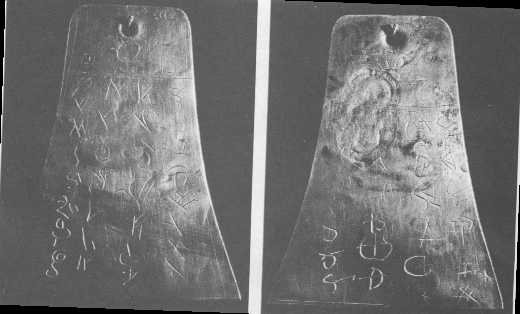
Early 1960s: M. Wilford Poulson, former instructor at Brigham Young University, discovered a single Kinderhook plate in the Chicago Historical Society Museum. It had been mislabeled as an “original gold plate of the Book of Mormon.”
1961: Commentary on the Book of Mormon, a work promoted in the Church’s Desert Book store included: “But, on the other hand, we have the fact before us, that the skeleton of the Pharaoh, found in Kinderhook, Illinois, referred to previously, was dug out of a large mound. …From this fact it is evident that some of the mounds are of very ancient date, as it is not supposable that this man would be the only one of his race and nation to be buried in this manner. We also suggest that this colony of Egyptians may have originated the style of architecture in this country in which so many find resemblances to the Egyptian, and which is specially characterized by the erection of vast truncated pyramids.” [11]
September 1962: Even at this late date, Welby W. Ricks, President of the BYU Archaeological Society, wrote in the Improvement Era: “A recent discovery of one of the Kinderhook plates which was examined by Joseph Smith, Jun., reaffirms his prophetic calling and reveals the false statements made by one of the finders..” [12]
1965: Upon examining the plates, at last, LDS physicist George M. Lawrence was disappointed with his conclusion “The dimensions, tolerances, composition and workmanship are consistent with the facilities of an 1843 blacksmith shop and with the fraud stories of the original participants.”
1978: This late edition of History of the Church continues to reiterate Clayton’s journal entry, “I have translated a portion…” as a “Comment of the Prophet on the Kinderhook plates.”
1979: Apostle Mark E. Peterson published a book called Those Gold Plates!, in which he offers the following on the Kinderhook plates: “There are the Kinderhook plates, too, found in America and now in the possession of the Chicago Historical Society. Controversy has surrounded these plates and their engravings, but most experts agree they are of ancient vintage.”
1980: The Chicago Historical Society, possessor of the single surviving Kinderhook plate, allowed LDS scholar Stanley P. Kimball to subject the plate to reliable testing in order to better understand its origins.
August 1981: The LDS Church’s Ensign magazine finally conceded that the Kinderhook plates are indeed the hoax their creators claimed: ”As a result of these tests, we concluded that the plate owned by the Chicago Historical Society is not of ancient origin…” The Church declared the plates to be “a nineteenth-century attempt to lure Joseph Smith into making a translation…” before pivoting to suggest that Joseph did not attempt to translate them. [13]
It is important to recognize that the Ensign article elaborates upon “interesting anomaly” on the physical plate – nicks and dents – to affirm that the rediscovered plate is the authentic Kinderhook plate #5. Apologists attempting to cast doubt upon the plate’s origin are essentially arguing with their own church.
CONCLUSION
Confronted with Smith’s own journal, the likelihood that William Clayton very likely accurately recorded the prophet discussing translating the bogus plates, and a third eyewitness confirmation of Smith’s identification of the inscriptions using his discredited GAEL, there no longer remains any reasonable doubt that the Kinderhook plates are a fraud and that Joseph Smith did proclaim to translate a portion of them. In translating the small portion of the plate that he did, Joseph Smith demonstrated that his discernment and translation abilities remained non-existent.
Joseph Smith had every opportunity to declare the Kinderhook plates fraudulent; yet he did not. Instead, it seems that he so wanted to believe that his translation abilities and the story of golden plates were supported by another similar discovery that he forged ahead.
It is highly recommended that the reader explore the events surrounding the LDS Church’s Book of Abraham narrative, which share many important parallels with the Kinderhook plates. After tasking the members with purchasing routine funerary scrolls and mummies, it took Smith years to reveal the ‘translation’ of the Egyptian papyrus, now known as the Book of Abraham.The Rosetta Stone has proven the Book of Abraham to be a completely incorrect translation, prompting a series of extraordinarily apologetic explanation attempts, such as how Smith surely examined the plates out of mere curiosity, relying solely upon his secular knowledge of foreign languages. Unfortunately, he was killed approximately a year following the introduction of the Kinderhook plates, resulting in endless speculation about what additional scripture he might have revealed had he been afforded further interactions with the plates.
LEARN MORE
Joseph Smith and the Kinderhook Plates, Utah Lighthouse Ministry
[1] William Clayton Journal / History of the Church, 372.
[2] Times and Seasons, 186-187.
[3] Diary of Brigham Young, LDS Archives.
[4] Reprinted in Ensign, August 1981, 73.
[5] Text portion of Nauvoo Neighbor broadside.
[6] Times and Seasons, 406.
[7] The Book of Mormon?, James D. Bales, 95-96.
[8] Full Fugate affidavit.
[9] Overland Monthly, Dec. 1890, 630.
[10] New Witnesses for God, 63.
B.H. Roberts further elaborated on the Church’s belief in the plates: “For while the statement in the text of the Prophet’s Journal to the effect that the find was genuine, and that he had translated some of the characters and learned certain historical facts concerning the person with whose remains the plates were found, may not have been known at the time to the alleged conspirators to deceive him, still the editor of the Times and Seasons-John Taylor, the close personal friend of the Prophet-took the find seriously, and expressed at once explicit confidence in an editorial in the Times and Seasons, of May 1st, 1843, that the Prophet could give a translation of the plates. And this attitude the Church, continued to maintain; for in The Prophet, (a Mormon weekly periodical, published in New York) of the 15th of February, 1845, there was published a fac-simile of the Kinderhook plates, together with the Times and Seasons editorial and all the above matter of the text.”
[11] George Reynolds and Janne M. Sjodahl, Commentary on the Book of Mormon, 6:232, 1961.
[12] Improvement Era, September 1962.
[13] Ensign, 73.

